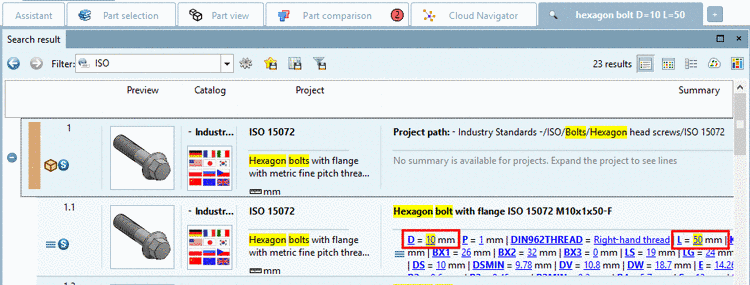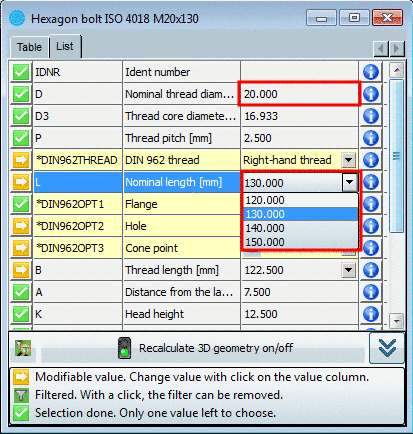Manual
Login
Our 3D CAD supplier models have been moved to 3Dfindit.com, the new visual search engine for 3D CAD, CAE & BIM models.
You can log in there with your existing account of this site.
The content remains free of charge.

Top Links
Manual
![[Note]](/community/externals/manuals/%24%7Bb2b:MANUALPATH/images/note.png) |
Note |
|---|---|
|
In this chapter you can find detailed information concerning Full-text search. This is opened and activated at program start. You can find detailed information concerning Variables search, Geometric search (3D), Sketch search (2D), Color search and Topology search when you click on the respective link. You can find information concerning setting options such as "Search for parts and part families" or "Search using Custom selection..., etc. under Search and part selection at a glance. Click on this link. | |
-
A term query is the actual basis for all queries.
-
Bolt
The term "Bolt" can occur anywhere, also as substring. Some examples:
-
Each term has to exist anywhere in the project. The sequence is irrelevant.
Bolt with shank Hexagon bolt M10x50
![[Note]](/community/externals/manuals/%24%7Bb2b:MANUALPATH/images/note.png)
Note "M10x50" is not yet a variable search in the real sense (on this see under Section 3.1.1.6.4.3, “ Variables search ”), but is contained as text in the table. So empty spaces between the single parameters make a difference. A query with "M 10 x 50" is not successful.
-
Differentiation of character types
ABC1234DEF
ABC-1234-DEF
ABC 1234 DEF
is also found.[34]
-
9876
00009876
-
-
A NOT operator can be used in order to exclude certain terms from the results. Different spelling can be used for this method.
Bolt NOT reduced shank Bolt !reduced shank
A hit "bolt with shank" for example can be filtered in this way.
Bolt flush mounted NOT not Bolt flush mounted !not
A hit "bolt not flush mounted" for example can be filtered in this way.
-
With the OR operator the search can be expanded to several terms. At least one of the terms has to apply.
Hexagon bolt OR Head cap bolt
-
Term query with AND Operator (Default!)
All terms connected by the AND operator have to be part of the result. This kind of query leads to the same result when no operator is used.
bolt AND shank bolt shank
16.2 21 90 16.2 AND 21 AND 90
-
Term query with defined sequence (phrase) => "xyz"
Using quotation marks (") you can determine that the contained terms have to occur in the given sequence.
A "query with phrase" is automatically generated when a term contains special characters or terms which are composed by characters and numbers.
AB1-455-PDA => "AB 1 455 PDA"
-
Prefix query (Term query with a wildcard at the end) => *
Note: The wildcard sign may only occur at the end of a term or a number!
Note: Adding a wildcard to a term affects the performance (negative)!
Note: Normally the wildcard search is not needed.
Bolt*
-
Wildcard query - Terms with a placeholder - ?
The placeholder '?' can only be used for order numbers. ? is for any single sign instead of the placeholder. Using several placeholders in a row at any position is possible.
ABC-5?6
-
Wildcard query for a whole directory
See Section 3.1.1.6.4.2.1.1, “Wildcard query for a whole directory ”.
-
Full-text search and Variables search can be combined in the input field. With numbers mm supposed.
Connect the variable name with certain values by using mathematical operators.
-
Variable name with concrete value
Hexagon bolt L1 = 400
-
In order to search for several variables, use mathematical operators.
Hexagon bolt L > 150 AND D = 20 Hexagon bolt L = 150 OR D = 20
-
Not only (=) can be used, but all established operators such as (=, <, <=, >, >=).
Hexagon bolt L >= 120 AND L < 160 AND D = 22
-
Hexagon bolts shall be found, either with the characteristic M10x50 or M10x60.
Hexagon bolt (M10x50 OR M10x60)
Bolts with material St37 or St70 shall be found.
Bolt (st37 OR st70)
-
Performing a wildcard search (*) in the Full-text search input field all projects of the directory set under Search in are outputted.
This can be interesting for a Cloud Map Search or also the export of the search result of a whole directory.
Save search results in a file
 :
:
The respective dialog box opens. Here you can specify the columns to be exported. You can save all search results or only the selected ones.
The following data are part of the index. Thus, for those it can be searched in all languages:
-
The Project path is displayed on the tabbed page Search results, on project level, in the column Summary.
When searching in another language than the set one (in the next figure exemplarily "schraube") you can see in the popup window under Hits (Treffer) where the hit is based on [NB (standard name), path and description].
-
In the following a search with "head cap bolt ISO" is conducted.
The respective terms are marked on the tabbed page Search results:
On project level: In Standard number (NN), Standard text (NT) and Project path
On line level: In Standard number (NN), Standard text (NT) and Standard name (NB)
-
Hits based on table values are marked in yellow on the tabbed page Search results as well. In the following example a search for "hexagon bolt D=10 L=50" has been performed.
While typing into the field Full-text search a list field is automatically opened and proposals are offered which can complete the search term.
Example: When "cd" is entered several cylinder designations such as "CDN" or "CDVI" are offered for example.
With the tab key you can overtake a selected term from the list, with the return key you can overtake a selected term and a search is directly executed.
The displayed proposals also depend on the selection under Search in.
![[Note]](/community/externals/manuals/%24%7Bb2b:MANUALPATH/images/note.png) |
Note |
|---|---|
|
The display of proposals does not automatically mean that a combination of terms really leads to hits, but instead that each single term exists.
| |
If Search for synonym  is activated, then the synonym database is
automatically searched based on the inserted keyword. A tooltip appears
with supplemental terms.
is activated, then the synonym database is
automatically searched based on the inserted keyword. A tooltip appears
with supplemental terms.
The synonym database can be enhanced be administration anytime. On this see under Section 1.1.8, “ PARTsynonym ” in PARTsolutions / PARTcommunity4Enterprise - Administration Manual.
When using the Full-text search, projects and link database are always searched together. Even if several search terms are used, it makes no difference whether hits score in the project file or in a LinkDB column.
On this see under Section 3.1.2.7.2, “ Enhanced search possibilities with ERP integration ”.
The following example shows a complete search with setting search options, result list and starting the part view.
Limit the search at "Current selection (ISO)" and leave the setting "Search for
 parts and part families".
parts and part families".-
Enter the following into the input field:
hexagon bolt L >= 120 AND L < 160 AND D = 20
Should you have removed the full-text search via click on
 from the list of search methods, then simply
click on the link
from the list of search methods, then simply
click on the link  .
.-> The Full-text search dialog box opens and you can perform an entry anew.
-
-> The search results are listed on the Search results tabbed page. When you click on the plus sign
 , then you can see the single parts of the part
family below. The following figure shows 4 lines, which exactly meet
the search criteria (D equals 20 and L is between 120 and 150).
, then you can see the single parts of the part
family below. The following figure shows 4 lines, which exactly meet
the search criteria (D equals 20 and L is between 120 and 150). -
Top left at the icon Search filter on/off
 you can recognize, that the characteristics
have been filtered. When you want to see all characteristics, click on
the icon.
you can recognize, that the characteristics
have been filtered. When you want to see all characteristics, click on
the icon.Also here you can recognize at the icon Search filter on/off
 , that the characteristics have been filtered.
When you want to see all characteristics, click on the icon.
, that the characteristics have been filtered.
When you want to see all characteristics, click on the icon.















![[Tip]](/community/externals/manuals/%24%7Bb2b:MANUALPATH/images/tip.png)







